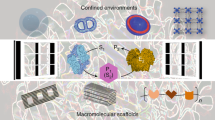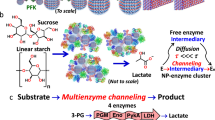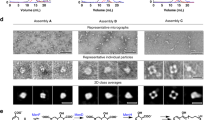Abstract
Swinging arms are a key functional component of multistep catalytic transformations in many naturally occurring multi-enzyme complexes1. This arm is typically a prosthetic chemical group that is covalently attached to the enzyme complex via a flexible linker, allowing the direct transfer of substrate molecules between multiple active sites within the complex2,3,4. Mimicking this method of substrate channelling outside the cellular environment requires precise control over the spatial parameters of the individual components within the assembled complex. DNA nanostructures can be used to organize functional molecules with nanoscale precision5,6,7 and can also provide nanomechanical control8,9,10,11. Until now, protein–DNA assemblies12 have been used to organize cascades of enzymatic reactions by controlling the relative distance and orientation of enzymatic components13,14,15,16 or by facilitating the interface between enzymes/cofactors and electrode surfaces17,18. Here, we show that a DNA nanostructure can be used to create a multi-enzyme complex in which an artificial swinging arm facilitates hydride transfer between two coupled dehydrogenases. By exploiting the programmability of DNA nanostructures, key parameters including position, stoichiometry and inter-enzyme distance can be manipulated for optimal activity.
This is a preview of subscription content, access via your institution
Access options
Subscribe to this journal
Receive 12 print issues and online access
$259.00 per year
only $21.58 per issue
Buy this article
- Purchase on Springer Link
- Instant access to full article PDF
Prices may be subject to local taxes which are calculated during checkout




Similar content being viewed by others
References
Perham, R. N. Swinging arms and swinging domains in multifuctional enzymes: catalytic machines for multistep reactions. Annu. Rev. Biochem. 69, 961–1004 (2000).
Mattevi, A. et al. Atomic structure of the cubic core of the pyruvate dehydrogenase multienzyme complex. Science 255, 1544–1550 (1992).
Jitrapakdee, S. et al. Structure, mechanism and regulation of pyruvate carboxylase. Biochem. J. 413, 369–387 (2008).
Zhou, P., Florova, G. & Reynolds, K. A. Polyketide synthase acyl carrier protein (ACP) as a substrate and a catalyst for malonyl ACP biosynthesis. Chem. Biol. 6, 577–584 (1999).
Seeman, N. C. Nanomaterials based on DNA. Annu. Rev. Biochem. 79, 65–87 (2010).
Fu, J., Liu, M., Liu, Y. & Yan, H. Spatially-interactive biomolecular networks organized by nucleic acid nanostructures. Acc. Chem. Res. 45, 1215–1226 (2012).
Pinheiro, A. V., Han, D., Shih, W. M. & Yan, H. Challenges and opportunities for structural DNA nanotechnology. Nature Nanotech. 6, 763–772 (2011).
Liu, M. et al. A DNA tweezer-actuated enzyme nanoreactor. Nature Commun. 4, 2127 (2013).
Liedl, T., Hogberg, B., Tytell, J., Ingber, D. E. & Shih, W. M. Self-assembly of three-dimensional prestressed tensegrity structures from DNA. Nature Nanotech. 5, 520–524 (2010).
Gu, H., Chao, J., Xiao, S. J. & Seeman, N. C. A proximity-based programmable DNA nanoscale assembly line. Nature 465, 202–205 (2010).
Andersen, E. S. et al. Self-assembly of a nanoscale DNA box with a controllable lid. Nature 459, 73–76 (2009).
Niemeyer, C. M. Semisynthetic DNA–protein conjugates for biosensing and nanofabrication. Angew. Chem. Int. Ed. 49, 1200–1216 (2010).
Erkelenz, M., Kuo, C-H. & Niemeyer, C. M. DNA-mediated assembly of cytochrome P450 BM3 subdomains. J. Am. Chem. Soc. 133, 16111–16118 (2011).
Fu, J., Liu, M., Liu, Y., Woodbury, N. W. & Yan, H. Interenzyme substrate diffusion for an enzyme cascade organized on spatially addressable DNA nanostructures. J. Am. Chem. Soc. 134, 5516–5519 (2012).
Wilner, O. I. et al. Enzyme cascades activated on topologically programmed DNA scaffolds. Nature Nanotech. 4, 249–254 (2009).
Delebecque, C. J., Lindner, A. B., Silver, P. A. & Aldaye, F. A. Organization of intracellular reactions with rationally designed RNA assemblies. Science 333, 470–474 (2011).
Teller, C. & Willner, I. Organizing protein–DNA hybrids as nanostructures with programmed functionalities. Trends Biotechnol. 28, 619–628 (2010).
Piperberg, G., Wilner, O. I., Yehezkeli, O., Tel-Vered, R. & Willner, I. Control of bioelectrocatalytic transformations on DNA scaffolds. J. Am. Chem. Soc. 131, 8724–8725 (2009).
Rowland, P., Basak, A. K., Gover, S., Levy, H. R. & Adams, H. J. The three–dimensional structure of glucose 6-phosphate dehydrogenase from Leuconostoc mesenteroides refined at 2.0 Å resolution. Structure 2, 1073–1087 (1994).
Chapman, A. D. M., Cortés, A., Dafforn, T. R., Clarke, A. R. & Brady, R. L. Structural basis of substrate specificity in malate dehydrogenases: crystal structure of a ternary complex of porcine cytoplasmic malate dehydrogenase, α-ketomalonate and tetrahydroNAD. J. Mol. Biol. 285, 703–712 (1999).
Fu, T. J. & Seeman, N. C. DNA double-crossover molecules. Biochemistry 32, 3211–3220 (1993).
Johnson-Buck, A., Nangreave, J., Jiang, S., Yan, H. & Walter, N. G. Multifactorial modulation of binding and dissociation kinetics on two-dimensional DNA nanostructure. Nano Lett. 13, 2754–2759 (2013).
Meisburger, S. P. et al. Polyelectrolyte properties of single stranded DNA measured using SAXS and single molecule FRET: beyond the wormlike chain model. Biopolymers 99, 1032–1045 (2013).
Candeias, L. P. et al. The catalysed NADH reduction of resazurin to resorufin. J. Chem. Soc. Perkin Trans. 2 11, 2333–2334 (1998).
Yang, H. et al. Nutrient-sensitive mitochondrial NAD+ levels dictate cell survival. Cell 130, 1095–1107 (2007).
Yan, H., Park, S. H., Finkelstein, G., Reif, J. H. & LaBean, T. H. DNA-templated self-assembly of protein arrays and highly conductive nanowires. Science 301, 1882–1884 (2003).
Acknowledgements
This work was supported by an Army Research Office MURI award (no. W911NF-12-1-0420 to H.Y., N.G.W. and N.W.W.), a National Science Foundation grant (no. 1033222 to N.W.W. and H.Y.) and an Army Research Office grant (no. W911NF-11-1-0137 to H.Y. and Y.L.). H.Y. is supported by the Presidential Strategic Initiative Fund from Arizona State University. The authors are grateful to J. Nangreave for her help in editing the manuscript and W. Li for his assistance with the FastScan AFM.
Author information
Authors and Affiliations
Contributions
J.F., H.Y. and N.W.W. conceived the concepts. J.F. and Y.Y. designed DNA nanostructures, performed the enzyme–DNA structure assembly and activity assay, and analysed data. A.J-B. performed the smFRET experiments and analysed data. M.L performed the 4 × 4 enzyme structures experiments. J.F., A.J-B. and Y.Y. wrote the manuscript. H.Y., N.W.W., Y.L. and N.G.W. discussed the results and commented on the manuscript.
Corresponding authors
Ethics declarations
Competing interests
The authors declare no competing financial interests.
Supplementary information
Supplementary information
Supplementary Information (PDF 9615 kb)
Rights and permissions
About this article
Cite this article
Fu, J., Yang, Y., Johnson-Buck, A. et al. Multi-enzyme complexes on DNA scaffolds capable of substrate channelling with an artificial swinging arm. Nature Nanotech 9, 531–536 (2014). https://doi.org/10.1038/nnano.2014.100
Received:
Accepted:
Published:
Issue Date:
DOI: https://doi.org/10.1038/nnano.2014.100
This article is cited by
-
Adaptive insertion of a hydrophobic anchor into a poly(ethylene glycol) host for programmable surface functionalization
Nature Chemistry (2023)
-
A temporally resolved DNA framework state machine in living cells
Nature Machine Intelligence (2023)
-
Fabricating higher-order functional DNA origami structures to reveal biological processes at multiple scales
NPG Asia Materials (2023)
-
Engineered repeat proteins as scaffolds to assemble multi-enzyme systems for efficient cell-free biosynthesis
Nature Communications (2023)
-
Redesigning Robust Biocatalysts by Engineering Enzyme Microenvironment and Enzyme Immobilization
Catalysis Letters (2023)



